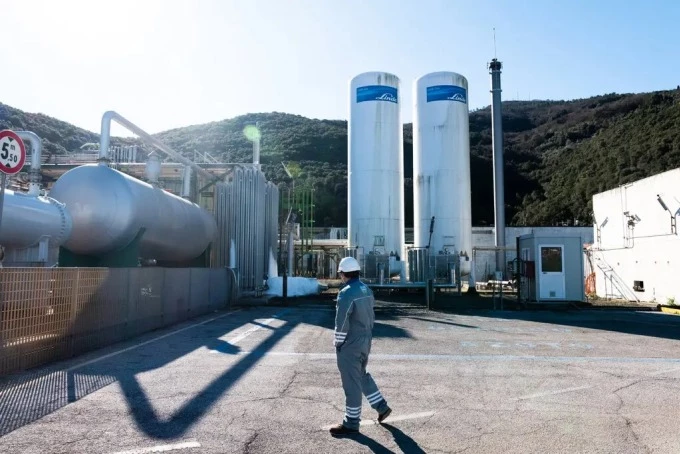

The energy "walking on a tightrope" plan of Europe
Apart from the risk of being cut off by Russia, a colder winter in Europe or Asia is enough to make the EU struggle even more.
As Russia tightens its gas supply, Europe must seek energy from all over to sustain economic activities. Gas supplies from Russia, once Europe's largest fuel source, have decreased by a third compared to a year ago.
Coal-fired power plants are being revived. Billions of dollars are being spent on terminal facilities to receive liquefied natural gas (LNG) from the US. Officials and heads of state fly to Qatar, Azerbaijan, Norway, and Algeria to finalize energy agreements.
According to the New York Times, Europe's fuel hunt has been notably successful so far. However, as gas prices continue to rise and the threat from Russia shows no sign of abating, the line between safety and crisis remains fragile.
Diversification efforts to find alternative solutions to Russian gas have largely offset the shortage. According to Jack Sharples, a member of the Oxford Institute for Energy Studies, despite Gazprom's cuts, total natural gas supply in Europe in the first half of 2022 was almost equal to the same period last year.
A significant contribution to offsetting the shortage of gas from Russia in the first half of the year is LNG transported by ships. About half of the supply comes from the US, which has become the world's largest fuel exporter this year. Looking towards the end of the year, Europe is pushing energy companies to fill storage facilities with gas to provide security in case Russia completely shuts off the gas valve. Europe's gas reserves are currently about 67% full, up more than 10 percentage points from a year ago. This level provides reassurance that European countries can achieve their target of 80% reserves before winter.

However, concerns are still increasing, and there are many reasons why Europe's efforts may fail as winter approaches. Analysts say that Russia is well aware of Europe's campaign to store enough gas, so they could make things difficult by continuing to restrict the gas supply.
Weather is also another unpredictable risk. An especially cold winter, a storm in the North Sea disrupting Norway's gas production, or a hurricane in the Atlantic delaying LNG tankers could all lead Europe into an energy shortage.
"We are approaching dangerous territory," said Massimo Di Odoardo, Deputy Head of Gas at the research organization Wood Mackenzie. These concerns are reflected in the European gas futures prices. It has doubled over the past two months, reaching about 200 euros per MWh on the TTF exchange in the Netherlands, about 10 times higher than a year ago.
Skyrocketing energy costs in Europe are putting many industries on the defensive, forcing them to make changes to meet the EU's target of 15% gas savings. The International Energy Agency recently forecasted a 9% decrease in gas demand in the region this year.
For instance, a steel plant owned by ArcelorMittal in Hamburg, Germany, has been using gas for years to extract iron and then feed it into electric furnaces. However, recently, they switched to purchasing input metals from a plant in Canada to access cheaper energy costs.
Natural gas prices in North America are only about one-seventh of the price in Europe. "Gas is so expensive that we can't afford it," said Uwe Braun, CEO of ArcelorMittal Hamburg.
Very few analysts or business leaders predict an improvement in the coming months. Instead, winter could pose more challenges for energy-intensive industries such as steelmaking, fertilizer production, and glass.
News of plant closures or production cuts is spreading. In Romania, ALRO Group recently announced the closure of production at a large aluminum plant and the dismissal of 500 workers due to high energy costs that made the company uncompetitive.
In some countries, including the UK and Germany, energy companies have not fully passed on the increased input costs to customers. This means difficulties for end-users are still ahead.
"The biggest risk now is the explosion of household and industrial energy prices this winter, something that the public and industry may find difficult to cope with," warned Henning Gloystein, Director of the Eurasia Group.
Liquefied natural gas, the primary alternative to gas from Russia for much of the continent, remains an expensive alternative. And Europe's increasing demand for LNG could hurt other regions in the world.
Fundamentally, Europe is bidding for LNG from other markets, mainly in Asia, where China, Japan, and South Korea are major consumers. Europe is "taking LNG out of the hands of markets that are not prepared to pay the price that Europe is willing to pay," according to Ben van Beurden, CEO of Shell. He finds this situation very frustrating.
Weather elsewhere is also crucial, not just in Europe. A cold winter in Asia - the main LNG consumer market - will increase competition with Europe in a context of limited global supply.
Countries like Germany and Romania are also taking different steps, including restarting or postponing the closure of coal-fired power plants. The International Energy Agency forecasts global coal demand to reach nearly 9 billion tons this year, equivalent to the peak level in 2013.
And there are many other variables that could disrupt Europe's winter energy plan. They have about 20 LNG receiving terminals but none in Germany.
Berlin is racing to build four facilities and has allocated 2.5 billion euros (2.55 billion USD) to lease floating LNG import terminals offshore. However, it is unclear when they will officially be operational and whether they will be ready for this winter or not.
Finally, it is very difficult to know where a large amount of gas will be supplemented from in the absence of Russia. "If we completely lose the supply from Russia, there won't be much room to increase supply from elsewhere," Jack Sharples said.
In the face of the gas crisis, the Dutch government has planned to close the massive Groningen gas field in the northern part of the country. This is one of the few large onshore natural gas sources in Europe. The reason is local concerns about earthquakes caused by gas extraction here.
Some observers question the Dutch government's reluctance to wake up the "sleeping giant" that could provide the equivalent of 40% of Germany's annual electricity consumption. They have decided to indefinitely suspend the closure of production wells in Groningen due to political instability.
However, the Netherlands simultaneously stated that they would only consider using this field "in the worst-case scenario." This position is likely to be tested in the coming months.
Source: VnEpress (According to NYT)


